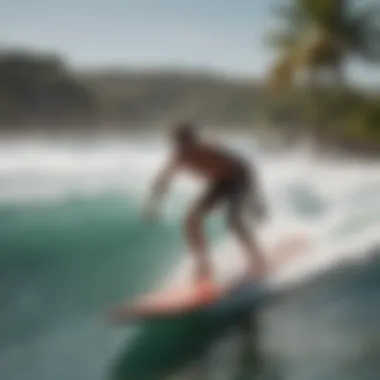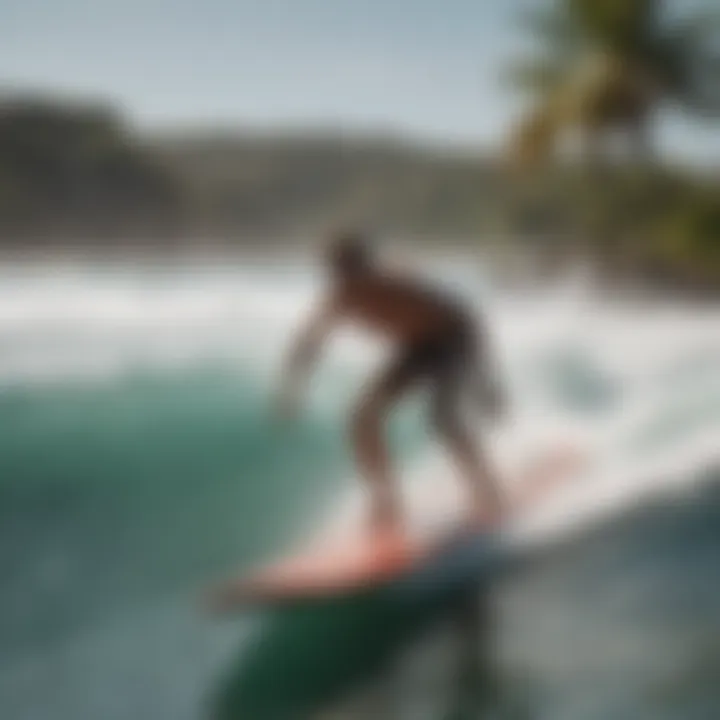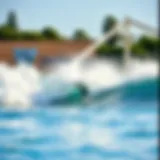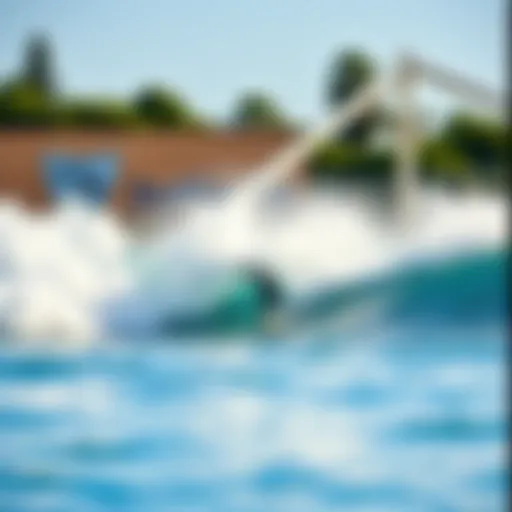Wakeboarding with a Surfboard: An In-Depth Guide


Intro
Wakeboarding with a surfboard is not just a thrill-seeking pastime; it’s an evolving sport that marries the spirit of surfing with the adrenaline of wakeboarding. This hybrid experience attracts those who crave the water's embrace while pushing their boundaries. In this guide, we will navigate through several aspects that define this unique activity. We'll cover the essentials of gear, delve into techniques for both beginners and seasoned riders, and explore safety precautions that can’t be overlooked as you carve up the waves. Furthermore, we will take a look at the community that binds wakeboard surfers together, offering insights into local forums and support networks that exist for sharing experiences and tips.
Whether you're just dipping your toes into this exhilarating sport or are a veteran looking to refine your skills, this guide aims to deepen your understanding and enjoyment.
Gear Essentials
To embark on your wakeboarding journey, it's crucial to have the right gear, as it lays the foundation for both performance and safety on the water.
Top Picks for Watersports Equipment
Choosing the right equipment can be the difference between floating gracefully on the water and struggling to stay afloat. Here are some key components you’ll need:
- Surfboard: Opt for a lightweight, high-performance surfboard designed specifically for wakesurfing. Popular options include brands like Liquid Force and Ronix, known for their balance and buoyancy.
- Wakeboard Boat or Jet Ski: You’ll need a powerful watercraft capable of generating the right amount of wake. Malibu Boats or MasterCraft are often favored for their impressive wake-making capabilities.
- Harness: A quality harness helps secure you during tricks. Make sure it fits comfortably, as comfort plays a big part in control.
- Life Jacket: Safety first! A well-fitted personal flotation device (PFD) is a must.
- Wetsuit or Rash Guard: Depending on the water temperature, these will help regulate your body temperature while offering protection from chafing.
Maintenance and Care Tips for Gear
Taking proper care of your equipment ensures longevity and peak performance. Here are some maintenance tips to follow:
- Rinse your gear with fresh water after each use to remove salt or chlorine buildup.
- Store your surfboard in a temperature-controlled space, avoiding extreme heat or cold to prevent warping.
- Regularly check the straps and buckles on your harness and PFD for wear and tear.
- After a day of wakeboarding, set aside time to inspect your equipment for any damage.
Techniques and Tips
Understanding the techniques of wakeboarding with a surfboard is key to maximizing fun and minimizing falls.
Beginner Tips for Each Watersport
To ease beginners into this challenging sport, consider these simple yet effective techniques:
- Find Your Stance: Experiment with your foot positioning on the board. Whether you're regular or goofy, comfort is key.
- Get to Know the Wake: Practice riding behind a boat and feeling the pull. Staying relaxed and leaning back slightly helps maintain balance.
- Start Slow: Don’t worry about speed initially. Gradually increase as you gain confidence and control.
Advanced Techniques for Skill Enhancement
For those seasoned in the art of wakeboarding, here are a few advanced techniques to elevate your game:
- Mastering the Pump: Learn how to pump your board to generate speed without pulling on the rope. This technique allows for smoother navigation and control.
- Balance Your Weight: Shifting your weight from your back foot to your front foot can enhance your turns, allowing for sharper maneuvers.
- Use the Wake: Take advantage of the boat's wake to perform tricks and jumps by timing your lift and landing.
“Wakeboarding with a surfboard combines the thrill of urban skate parks with the fluidity of the ocean waves.”
Preface to Wakeboarding and Surfboards
In the realm of watersports, combining the thrilling elements of wakeboarding and the fluid grace of surfing with a surfboard creates a unique aquatic experience. Understanding the fundamentals of both wakeboarding and surfboards is essential for anyone looking to dive into this exciting hybrid activity. By grasping the core concepts, one can appreciate the art of wakeboarding, and also, the advantages of using a surfboard in this context.
Defining Wakeboarding
Wakeboarding can be defined as a surface water sport in which one rides a wakeboard while being towed behind a boat. It requires a mixture of balance, technique, and synergy with the water. The origins of wakeboarding can be traced back to the late 1980s, where elements of surfing, water skiing, and skateboarding blended together to create a new activity. The thrill comes not only from slicing through the water but from mastering jumps and tricks that enhance the riding experience.
For many, wakeboarding isn’t just a sport; it is a lifestyle. One can find oneself surrounded by a vibrant community, where camaraderie is formed over shared experiences and achievements on the water. It is important to note the learning curve; novices may find it tricky at first, but with practice, the ride becomes smoother and more exhilarating. Furthermore, wakeboarding with a surfboard adds a distinctive flair to the sport with unique challenges and rewarding experiences.
Overview of Surfboard Design
Surfboard design plays a crucial role in the wakeboarding experience. Although typical wakeboards are shorter and wider, utilizing a surfboard introduces different dynamics. Surfboards are longer and sleeker, often promoting a fluid movement through the water and enabling better carving on the wake.
There are several key components in surfboard design that impact performance:
- Shape: The outline of the surfboard affects maneuverability and stability. Different shapes cater to various styles of riding.
- Volume: Referring to the amount of foam used in a surfboard, volume influences buoyancy and overall feel on the water. A board with more volume tends to float better.
- Fin setup: Fins serve as stabilizers and determine how a board reacts to turns. More fins generally offer better grip but may sacrifice some maneuverability.
Choosing the right surfboard for wakeboarding can hugely impact your experience in the water. Selecting one with thoughtful design elements not only enhances control but also elevates the enjoyment of every ride.
"The right surfboard can transform your wakeboarding journey from ordinary to extraordinary, making each wave an adventure to remember."
In summary, embracing the intricacies of wakeboarding and understanding surfboard designs form the foundation of a fulfilling experience in watersports. The juicy details surrounding these subjects set the stage for diving deeper into this comprehensive guide.
The Evolution of Watersports
Watersports have a rich history, evolving from simple recreational activities to complex hybrid sports that merge different techniques and styles. The evolution of these sports, particularly wakeboarding with surfboards, is crucial to understanding not just the mechanics involved but also the cultural shifts that have shaped the way we engage with water. When we look at the journey watersports have taken, we see a tapestry of innovation and adaptation, which reflects the ways in which technology, lifestyle, and personal expression intertwine.
Historical Context of Wakeboarding
Wakeboarding finds its roots in the surf culture of the 1970s, a time when boundaries of boardsports were being pushed. Early practitioners on the waters began experimenting with various styles to enhance their experience. It’s fascinating to note that the sport was initially a blend of surfing, snowboarding, and water skiing techniques. One creative soul, Dave Wiggins, laid foundations during this time by connecting a surfboard to a ski boat.
The rise of specialized wakeboards in the 1980s added a different dimension; they replaced the makeshift boards with designs that enhanced performance. Those boards were tailored to create speed and maneuverability, allowing for tricks and jumps that would soon become staples of the sport. But this wasn’t just about equipment. The lifestyle surrounding wakeboarding also expanded, creating a community that embraced thrill-seekers and sport enthusiasts alike. This growth laid the groundwork for wakeboarding as we know it today—a blend of styling and functional performance.


Rise of Surfboard Utilization in Wakeboarding
With advances in materials and design, surfers began to see potential in their boards for pulling tricks behind boats. In particular, the classic longboard and shortboard designs offered unique advantages in wakeboarding, allowing for different performance capabilities on the water. Surfers quickly adapted their skills, taking to lakes and rivers not just with traditional wakeboards but with surfboards that resonated with their roots.
The introduction of surfboards into wakeboarding created a distinct subculture within the sport. Now wakeboarding is not just seen as an option for ski enthusiasts—it has its unique followers who treasure the excitement of riding on different water surfaces with varying conditions.
"The beauty of utilizing surfboards in wakeboarding is the versatility they offer. Riders can transition seamlessly between different styles and techniques, capturing the essence of both worlds."
The influence of surfing on wakeboarding is significant; boards designed for ocean waves translate well onto calm waters. Factors like board length, skim shapes, and fins can drastically influence performance, allowing riders to express individuality and creativity.
The connection continues to grow, fueled by the camaraderie shared among these water sport enthusiasts. As we advance into the future, who knows what new innovations might arise from this relationship? Understanding this evolution offers insights not only into riding techniques but also into the broader sphere of watersports culture.
Fundamental Techniques in Wakeboarding with a Surfboard
Understanding the fundamental techniques in wakeboarding with a surfboard is essential for any participant looking to navigate this exhilarating water sport effectively. Mastery of these techniques not only boosts confidence but also enhances overall performance. When you get the hang of things like balance, starting and stopping, and maneuvering, your time on the water becomes more enjoyable and safer. Each technique plays a crucial role, with a direct impact on your ability to ride smoothly and execute tricks.
Balancing Techniques
When it comes to wakeboarding with a surfboard, balance is the name of the game. This aspect can make or break your experience on the water. As you gain speed behind the boat, you will feel the force pulling you, and your center of gravity will shift.
To establish a solid grip on balance, consider these tips:
- Body Positioning: Keep your knees bent and fall slightly forward. Your feet should be shoulder-width apart, which provides a sturdy base.
- Core Engagement: A strong core is essential. Not only does it help maintain balance, but it also allows for better control over your movements.
- Vision: Keeping your eyes fixed on the direction you want to move is crucial. Your body naturally follows where your gaze goes.
It's often said that wakeboarding is much like riding a bike; once you get it, it's hard to forget. With practice, balancing will become second nature.
Starting and Stopping Methods
Starting and stopping efficiently can drastically change the flow of your wakeboarding session. The correct techniques help you avoid unnecessary splashes and increase your overall control.
Here’s how to start and stop like a pro:
- Starting:
- Stopping:
- Begin with the board on your feet while in the water, lying back with your arms straight.
- As the boat starts moving, resist pulling yourself up too quickly. Let the tension in the rope bring you up gradually.
- Position your feet correctly, ensuring that the back foot has a bit more weight as it presses down. This will help get you to an upright position smoothly.
- To stop, signal the boat driver, preferably with a raised arm, before straightening your legs slightly.
- Shift your weight back and bend your knees slightly to slow down naturally before the boat cuts off power.
These methods contribute to a safer experience while giving you the ability to navigate the waters without unnecessary fuss.
Turning and Maneuvering Strategies
Turning and maneuvering your surfboard while wakeboarding can feel challenging at first, but with the right techniques, it becomes incredibly intuitive. Finessing your turns can lead to exciting tricks and improved overall skill.
Here’s how to master the art:
- Edge Control: To turn, start by shifting your weight towards your heels or toes, which will dig the board's edge into the water. This friction is what initiates your turns.
- Body Movement: Lean your shoulders in the direction you want to go, while maintaining a low center of gravity. This connection between weight distribution and body alignment plays a critical role.
- Speed Regulation: More speed can mean sharper turns, while slowing down will give you wider arcs. Knowing how to adjust your speed based on the turn you wish to execute is vital.
"Turning is not just about moving your board; it's about coordinating your whole body to create a seamless flow."
Being mindful of these strategies will allow for a more fluid riding experience, making it easier to adapt to various water conditions and shapes you might face.
In summary, honing in on these fundamental techniques is not just about learning how to stay upright; it’s about creating an enjoyable and fulfilling experience on the water. The better you become at balancing, starting, stopping, and maneuvering, the more fun you’ll have while exploring the thrill of wakeboarding with a surfboard.
Essential Equipment for Wakeboarding with a Surfboard
When it comes to wakeboarding with a surfboard, the right equipment plays a crucial role in ensuring a smooth and enjoyable experience. The nuances of this sport require specific tools that not only accommodate the unique dynamics of wakeboarding but also enhance the overall performance on the water. Without the appropriate gear, even the most skilled wakeboarder might find themselves grappling with balance issues or inefficiencies in maneuverability. The focus here is on ensuring safety and optimizing performance.
Choosing the Right Surfboard
Selecting the right surfboard is paramount in wakeboarding, and this decision can make or break your experience on the water. Not all surfboards are created equal when it comes to wakeboarding; understanding the various types and their features can influence your performance significantly.
- Types of Surfboards: There are several surfboard designs available, including fish, fun shape, and shortboards. Each has different characteristics suited to various riding styles. For wakeboarding, many prefer a wider and thicker board, as it provides more stability on the water, which is essential for beginners.
- Size Matters: The size of the surfboard is another critical factor. A longer board may offer better glide and stability, while a shorter board often allows for more maneuverability and tricks. The ideal length typically ranges between 5'4" to 6'. However, it also depends on the rider’s weight; heavier riders should consider larger boards for added buoyancy.
- Construction Material: Different materials like epoxy and polyurethane boast distinct advantages. Epoxy boards are lighter and offer better buoyancy, making them a popular choice among wakeboarders. Conversely, polyurethane boards often provide a more traditional feel and flexibility.
In essence, examining your own riding style and comparing board options can lead to a more tailored choice, ultimately enhancing your skills on the water.
Wakeboard Ropes and Handle Selection
Just as vital as the surfboard itself is the choice of wakeboard rope and handle. These components facilitate control and stability while riding, which can significantly affect performance.
- Length of the Rope: Wakeboard ropes typically range from 60 to 80 feet. A longer rope can add to the challenge, as it requires more strength and control, while a shorter rope can provide a more stable ride. Beginners might benefit from starting with a longer rope to allow for learning and adjustment period.
- Material and Grip: It's crucial to select a rope made from durable materials that can withstand wear from water and sun exposure. Handles often come with various grip options, including rubber or foam grips. A handle with a solid grip ensures your control, especially during tricky maneuvers, making it vital for both safety and style.
- Connection Points: The way the rope connects to the handle also matters. Some may prefer a non-stretch rope, which ensures direct power transfer from the boat to the rider, enhancing responsiveness. Others might opt for a slightly stretchy rope which can absorb shocks better, ultimately providing a smoother ride.
Choosing the right wakeboard rope and handle is not just about comfort; it's about finding the right tool to help you master your skills and embrace the thrilling experience of wakeboarding.
"The proper equipment can elevate your performance and directly impact your enjoyment on the water. Invest wisely, and your body will thank you later."


Safety Considerations in Wakeboarding
In the thrilling world of wakeboarding with a surfboard, safety is as crucial as mastering the tricks themselves. Participants often find themselves navigating challenge-laden waters while being pulled at high speeds. Therefore, prioritizing safety can make a significant difference between enjoying the ride or facing potential mishaps. Understanding the risks and implementing precautionary measures protects not only the rider but also everyone in the surrounding area.
Having a grasp of safety considerations helps create a more enjoyable environment for all water enthusiasts. As surfers, paddleboarders, and kitesurfers intertwine in various water spaces, knowing how to navigate and respect conditions can foster a community that promotes fun while protecting each other.
Understanding Water Conditions
Before you even think about hitting the water, understanding what lies beneath the surface is vital. Factors like currents, tides, and weather significantly impact your wakeboarding experience.
- Currents: Strong currents can easily throw off balance. If the water looks rough or fast-moving, it’s better to wait for calmer conditions.
- Tides: High and low tides can alter the landscape of the water. A low tide may expose obstacles like rocks, while high tide might push riders closer to shore hazards.
- Weather: Sudden changes can catch anyone off guard. Storms can lead to choppy waters, potentially increasing risks.
Watch for local advisories and consider checking websites or forums like Reddit or Facebook where seasoned wakeboarders share experiences about water conditions at different spots.
Always check the forecast before setting out. Better to err on the side of caution than to test Mother Nature's patience. A good rule of thumb is this: "If it doesn’t feel right, it probably isn’t."
Recommended Safety Gear
Equipping yourself with the suitable safety gear ensures you're prepared for unexpected events. This equipment shouldn't be considered optional—it’s foundational for any wakeboarder looking to stay safe while enjoying the sport.
- Life Jacket: A personal flotation device is non-negotiable. Opt for a jacket that fits well but doesn’t restrict your movement. Make sure it’s Coast Guard approved.
- Helmet: Protecting your head is essential, primarily when learning new moves or during falls. A helmet specifically designed for watersports can absorb impacts better than a standard one.
- Impact Vest: An additional layer can shield against hits with the water or your surfboard.
- Wetsuit: Depending on the water temperature, a wetsuit offers warmth and protection against minor cuts and injuries.
Safety is not just a gear thing; it’s a mental state. Always be aware of your surroundings and potential hazards!
Ensuring you have reliable and appropriate gear enhances your experience, allowing you to focus on learning new tricks and mastering the basics without worrying about accidents. In wakeboarding, just like in life, a little preparation goes a long way.
Common Challenges and Solutions
The world of wakeboarding with a surfboard, while exhilarating, is not without its hurdles. Understanding these challenges and developing effective strategies to overcome them is crucial for anyone wanting to thrive in this watersport. It’s about what you’re up against, how to navigate those tricky waters (quite literally), and the tools and mindset you need to keep pushing forward.
Dealing with Balance Issues
Balance is paramount in wakeboarding, and many newcomers find themselves grappling with how to maintain it on a surfboard. Unlike traditional wakeboards, surfboards can be notably less forgiving when it comes to stability. Here are some key considerations to help combat balance woes:
- Foot Positioning: Where you place your feet plays a significant role in your stability. A wider stance helps you feel more grounded while adjusting to the water’s motion.
- Core Strength Training: Engaging in exercises that strengthen your core can substantially improve your balance on the board. Activities like yoga or Pilates can make a world of difference.
- Practice on Land: Getting familiar with the feel of the surfboard on solid ground can ease the transition once you hit the water.
Remember, it’s common to tip or faceplant at first. Just think of it as part of learning—every fall teaches you something new.
Overcoming Fear and Anxiety
Many aspiring wakeboard surfers find fear and anxiety creeping in, especially when faced with the prospect of being out on the open water. Here are some strategies to address these feelings:
- Gradual Exposure: Start by practicing in calm water and gradually progressing to more challenging conditions. Getting comfortable with small steps can alleviate anxiety.
- Breathe and Focus: When nerves start to rise, take deep breaths. Centering your thoughts can help clear the mind, allowing you to focus on technique rather than fear.
- Visualize Success: Spend a few moments picturing yourself successfully gliding over the water. Visualization can alter your mindset and build your confidence.
"The only thing we have to fear is fear itself." - Franklin D. Roosevelt
This quote rings particularly true in wakeboarding. When anxiety hits, remind yourself that the first time you encounter any new skill will come with its own set of nerves. You’re not alone in this!
By tackling balance issues and addressing fear head-on, you're not just improving your skills; you're also cultivating resilience and perseverance in what can be a challenging yet rewarding venture.
The Community Aspect of Wakeboarding with a Surfboard
Understanding the community aspect of wakeboarding with a surfboard is essential for any enthusiast. It's not just about riding the waves proficiently; it’s about forming bonds and sharing experiences with others who are equally passionate about the sport. Being part of a community can enhance your enjoyment and provide valuable insights.
In essence, local groups and online platforms are lifelines for wakeboarders. They offer a space where one can obtain tips, share stories, and find support. It's an opportunity to connect with veterans of the sport who can lend advice that books or videos simply cannot. Additionally, sharing the thrill of catching a wave can forge lasting friendships that extend beyond the water.
Finding a Local Wakeboarding Group
Finding a local wakeboarding group can greatly elevate your experience. Whether you're a newbie or an experienced rider, being surrounded by others can motivate and challenge you to improve. Most likely, local communities operate within clubs or teams. These groups often organize events, competitions, and practice meets.
- Check local water sports shops as they frequently advertise community events.
- Visit local parks where wakeboarding might be popular. Sometimes, you just need to strike up a conversation with fellow riders.
- Social media platforms like Facebook often have specific groups dedicated to wakeboarding. Joining these can provide insights into local gatherings and opportunities for practice sessions.
Here are some points to consider while seeking out a group:
- Skill Level: It’s helpful to find a group that matches your skill level to engage comfortably.
- Schedule Flexibility: Look for a community that accommodates your availability.
- Goals: Your objective, whether it's to compete or socialize, can influence your choice of group.
Engaging with Online Forums and Social Media
In today's digital age, online forums and social media are invaluable resources for wakeboarders. Whether it’s Reddit, Facebook, or dedicated sports forums, engagement in these platforms opens doors to a wealth of knowledge and camaraderie.
Benefits of Online Engagement:
- Diverse Perspectives: You can learn different techniques and approaches from global wakeboarders.
- Troubleshooting: Posting questions about specific challenges can yield rapid responses from experienced riders.
- Finding Events: Many online groups announce competitions and gatherings, making it easier to participate.
"The beauty of online engagement lies in the freedom to interact with likeminded individuals without geographical boundaries. You can literally chat with someone halfway across the globe about your shared passion."


To maximize your involvement in online communities, consider the following:
- Be respectful and constructive in discussions, as this fosters a positive atmosphere.
- Share your own experiences and tips; contributing enriches the community.
- Follow key influencers and groups that focus on wakeboarding and surfboarding for the latest trends and techniques.
In summary, being part of a wakeboarding community, whether local or online, can significantly enhance both your skill and enjoyment of the sport. Interacting with others not only helps improve your techniques through shared learning but also cultivates deeper relations with fellow water enthusiasts.
Comparative Exploration: Surfboarding vs. Traditional Wakeboarding
Understanding the nuances between surfboarding and traditional wakeboarding is essential for anyone looking to delve deeper into these exhilarating watersports. It’s more than just a matter of personal preference; the differences can affect performance, skill requirements, and even enjoyment on the water. Each discipline showcases unique characteristics, yet they both stem from a shared love for riding water.
Technical Differences
When we look at the technical aspects, surfboarding and traditional wakeboarding reveal some striking distinctions.
- Board Design: Surfboards are generally longer and narrower compared to traditional wakeboards, which tend to be shorter and thicker. This design difference means that surfboards are made to glide over waves while maintaining speed and maneuverability. On the flip side, wakeboards are crafted to handle the pull of a boat and facilitate tricks, offering a more stable platform for jumping and spinning.
- Riding Technique: The technique for riding varies considerably. Surfboarding utilizes a more fluid technique, relying on the power of ocean waves to create momentum. Riders find themselves using their weight to shift and catch the wave, typically leading to a more dynamic, reactive style. Traditional wakeboarding, however, demands a strong initial pull from the boat, meaning athletes must master the balance between maintaining tension on the rope while executing various tricks.
- Bindings: Surfboards often have little to no bindings, which allows for a looser, freer ride. In contrast, wakeboards typically include bindings that attach the rider's feet securely to the board, enhancing trick execution yet somewhat limiting the freedom of movement.
These technical differences have far-reaching implications for how one experiences each sport. Understanding these distinctions can greatly influence the choice of gear and suitable techniques for aspiring riders.
Performance and Style Variances
The performance and style between surfboarding and traditional wakeboarding also diverge considerably, greatly affecting how athletes express themselves on the water.
- Speed and Agility:
Surfboarding thrives on the natural flow of the wave. This means that riders can achieve impressive speeds by smoothly blending their moves with the wave's rhythm. Conversely, traditional wakeboarding often centers around speed created by the boat’s pull. Riders perform tricks at these high speeds, which can enhance the spectacle but require a different set of skills. - Tricks and Moves:
When it comes to tricks, each discipline boasts its own style. Surfboards lend themselves to more fluid, carving movements that enhance style and grace. Movements can blend seamlessly into the waves. In contrast, wakeboarding tricks may often focus on aerial maneuvers and more acrobatic displays, utilizing the boat's wake as a launch pad for various flips and spins. - Cultural Influences:
Let's not forget the cultural aspects surrounding each sport. Surfboarding has a rich history linked to the ocean, often grounded in a lifestyle tied to beach communities. Traditional wakeboarding, in many cases, finds its home in lake environments, giving rise to a different community and vibe altogether.
In the end, whether one opts for surfboarding or traditional wakeboarding, both provide unique avenues to enjoy the water while showcasing certain skills and personality. The choice could easily depend on personal style, preference for riding conditions, or the community one wishes to join.
"The essence of these sports lies not just in the technique or performance but in the joy of riding the waves or wakes. Embrace the journey, wherever it may lead you."
Both disciplines are worthy of exploration and can even coexist within an athlete's repertoire, enriching their overall watersport experience.
The Future of Wakeboarding with Surfboards
The landscape of wakeboarding with surfboards is evolving rapidly. This evolution is driven by advancements in technology, a constant push for innovation, and an ever-growing community of enthusiasts. Understanding where this sport is heading gives participants a leg up in perfecting their skills and equipment.
As the watersport world continues to blend elements from various disciplines, wakeboarding with surfboards stands to gain significantly. Modern surfers and wakeboarders alike are increasingly embracing hybrid equipment and techniques, which enhances the sport's appeal.
Innovation doesn’t just enhance performance; it opens doors for new audiences. This distinctive crossover with traditional surfing garners interest from diverse groups. Essentially, the future promises an enriched experience with every ride.
Emerging Trends and Innovations
New trends are popping up like daisies on a sunny day. Many companies are redesigning surfboards specifically for wakeboarding, making them lighter and more robust. These changes lead to better buoyancy and improved maneuvers. Beyond hardware, there are shifts in training approaches too. Virtual reality and drone footage are being used for instructional purposes, offering unique insights to athletes.
- Eco-Friendly Materials: Many brands are leaning towards sustainable materials.
- Smart Technologies: Emerging tech is finding its way into wakeboarding gear, providing real-time data on performance.
- Community Focus: Augmented community interactions through social apps and forums are gaining traction, allowing for an exchange of tips and experiences.
These trends hint at a more connected and efficient sport. The integration of smart technology could lead to opportunities for real-time feedback, which could help wakeboarders refine their techniques on the water.
Potential Evolution of Equipment and Techniques
As we peer into the crystal ball of wakeboarding, it looks like equipment will continue to evolve. The next generation of surfboards might incorporate more flexible designs, enabling riders to perform complex tricks with ease. Equipment designs are moving toward lightweight construction while ensuring durability, allowing even beginners to experience a feeling of freedom on the water.
Things are also getting interesting at the technical level:
- Increased Customization: Expect to see more brands offering custom-built boards tailored to individual styles.
- Hybrid Ropes: The design of wakeboard ropes might change to accommodate tricks that blend styles from surfing.
- Waterway Innovations: New wake parks are being designed with innovative setups that mimic ocean waves, creating a more authentic surfing experience.
The potential for developing unique techniques is there as well. Athletes might blend wakeboarding skills with traditional surfing moves, creating an entire new repertoire of tricks.
Future advancements in wakeboarding with surfboards not only promise improved performance but also aim to expand the horizons of what is possible within the sport.
In summary, as technology leaps and the community evolves, wakeboarding with surfboards stands at the brink of transformation. Those involved in this hybrid watersport should keep their eyes peeled for the exciting developments that lie ahead.
Finale: Reflecting on the Practice
As we draw the curtain on this exploration of wakeboarding with a surfboard, it is vital to appreciate how this hybrid sport not only challenges conventional perspectives on recreational watersports but also enriches the experiences of participants. Wakeboarding itself has long been a thrilling activity, but the integration of surfboard techniques invites a fresh level of creativity and expression on the water.
The nuances of wakeboarding with a surfboard revolve around several specific elements that enhance both the enjoyment and the skills of those involved. Understanding these intricacies can significantly elevate one’s performance, allowing for more dynamic moves and a greater connection to the water.
Summary of Key Insights
In summarizing the insights gained throughout this guide, a few key points stand out:
- Emphasis on Balance: The foundational skills required for balance remain paramount. This can involve rigorous practice, especially for beginners who may feel unsteady on the board.
- Community Engagement: The power of community cannot be overstated. Engaging with local groups or online forums fosters a sense of belonging and provides valuable resources and support for learners and experienced wakeboarders alike.
- Adaptability of Techniques: The ability to adapt wakeboarding techniques to suit individual styles while using a surfboard is crucial. This adaptability can lead to discovering unique tricks that are signature to one’s personal approach.
These insights serve not just as reminders but as vital steps toward mastering the sport while having fun.
Encouragement for Continued Learning and Exploration
Do not let the journey end here. The world of wakeboarding with a surfboard is teeming with potential for growth and exploration. Every time you hit the water, there’s something new to learn, whether it's perfecting an aerial trick or merely gaining comfort on the board in varying conditions. Consider embracing the following suggestions:
- Join Workshops: Various organizations regularly host workshops. These can be a great opportunity to refine your skills while meeting like-minded people.
- Practice Regularly: Make a habit of going out on the water as often as possible. Consistency in practice leads to improvement.
- Experiment with Different Boards: Trying different types of surfboards can unlock new techniques or styles that suit your riding preferences.
- Stay Updated: Follow advancements in equipment and techniques through surfing and wakeboarding forums. The community thrives on shared knowledge.
Remember that the aquatic world is vast and ever-growing. The more you dive in—both literally and metaphorically—the richer your experience will be. Your exploration is not just about being a wakeboarder; it’s about becoming a part of a vibrant community that celebrates the unique blend of skills, passion, and adventure that each individual brings to the sport.



